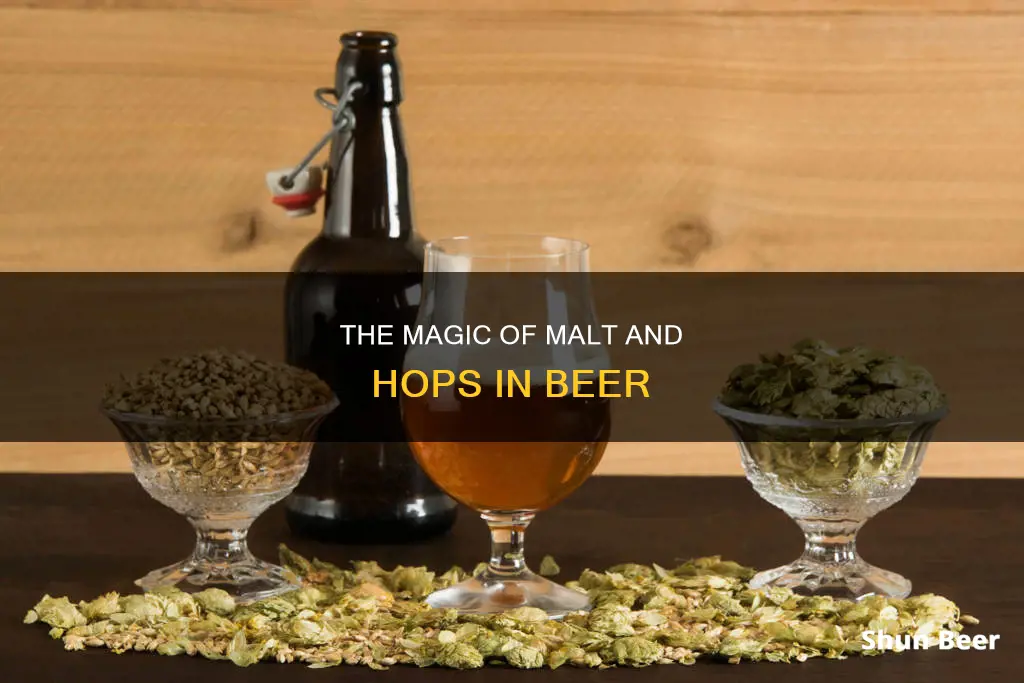
Malt and hops are two of the four essential ingredients in beer, the other two being yeast and water. Malted cereal grains (usually barley) are the base of the beer flavour triangle, providing the sugars that are fermented by the yeast to create alcohol and CO2. They are also the primary source of beer colour and contribute significantly to flavour and mouthfeel. Hops, on the other hand, are the flowers of the hop plant Humulus lupulus, a member of the Cannabaceae family of flowering plants. They are added to beer to provide bitterness, flavour, and stability, balancing the sweetness of the malt. They also have antibacterial effects, inhibiting the formation of certain spoilage-causing bacteria.
Malt and Hops in Beer
| Characteristics | Values |
|---|---|
| Malt Type | Barley malt, wheat, rye, oats |
| Malt Function | Provides sugars for fermentation, colour, flavour and mouthfeel |
| Malt Flavours | Bread-like, toasty, honey, grain, nutty, chocolate, coffee, smoky |
| Hop Type | Flowers of the hop plant Humulus lupulus |
| Hop Function | Adds bitterness, flavour, aroma, stability and antibacterial properties |
| Hop Flavours | Citrus, pine, floral, fruity, spicy, herbal, tropical, woody, earthy |
What You'll Learn
- Malt is made from grains, which are fermented by yeast to create alcohol and CO2
- Hops are the flowers of the hop plant, a member of the hemp family
- Malted grains are sprouted and kilned to break down starches into carbohydrates
- Hops provide bitterness to balance the sweetness of malt, as well as flavours and aromas
- Malted barley is dried and heated to intensify its flavour and colour

Malt is made from grains, which are fermented by yeast to create alcohol and CO2
Malt is an essential ingredient in beer. It is made from grains, which are fermented by yeast to create alcohol and CO2. The most common malted grain used in the brewing process is barley, but other grains such as wheat, rye, and oats can also be used. The malting process involves multiple steps, including steeping, germinating, and roasting the grains. This process activates enzymes within the grain that break down the hard, starchy insides into simpler carbohydrates, making them accessible to the brewer.
The malt provides the sugars that are fermented by the yeast to create alcohol. It also gives the beer its colour and contributes significantly to its flavour and mouthfeel. The different types of malt used can impart a range of flavours to the beer, such as bread-like, toasty, honey, grain, nutty, chocolate, coffee, and smoky.
In addition to malted grains, some unmalted cereal grains are also used in brewing, including corn, rice, wheat, rye, oats, and sorghum. The choice of malt and yeast combination is crucial in pulling the best character out of the hops used in the brewing process.
Exploring the Hops in Your Beer: Gallon Edition
You may want to see also

Hops are the flowers of the hop plant, a member of the hemp family
Hops impart a range of flavours and aromas to beer, including floral, fruity, citrus, spicy, piney, and earthy notes. The specific flavours and aromas depend on the variety of hops used and the region in which they are grown. The chief hop-growing regions are the Northwestern US, Southern England, Germany, the Czech Republic, and China.
Hops play a crucial role in brewing, providing aroma and bitterness. They are often associated with India Pale Ales (IPAs), a very hop-forward style of beer. However, hops can produce a wide array of aromas, ranging from fresh pine needles to ripe mango.
Hops are added during the boiling of the wort (the sugar-rich liquid produced from malt) to give the desired taste, colour, and improved shelf life. The degree and type of bitterness depend on the type of hops used, the amount added, and the stage at which they are added during the brewing process.
Brewing Beer Without Hops: Is It Possible?
You may want to see also

Malted grains are sprouted and kilned to break down starches into carbohydrates
Malted grains are an essential ingredient in the production of beer. The malting process involves steeping, germinating, and drying grains to convert them into malt. This process is crucial for breaking down the starches in the grains into simpler carbohydrates, which can then be utilised by yeast during fermentation to produce alcohol.
During malting, grains such as barley, wheat, rye, or sorghum, undergo a controlled germination process. This means that they are soaked in water, causing them to sprout, and then quickly dried to halt the germination. This controlled germination results in the production of enzymes that can break down the complex starch molecules in the grains.
The germination process can be further divided into two main stages: steeping and kilning. In the steeping stage, the grains are soaked in water, initiating the sprouting process. The grain's moisture content increases from around 12% to between 40% and 45%. This is achieved through a cycle of wet stands, where the grain is submerged, and air rests, where the water is drained. The first sign of germination is the appearance of rootlets, known as "chit".
Once the desired level of germination is reached, the kilning process begins. The grain is dried to stop further sprouting and preserve the enzymes. The kilning process involves two stages: free drying and forced drying. In the free drying stage, the air temperatures are kept cool to gently dry the grain without damaging the enzymes. In the forced drying stage, the air temperature is increased to further dry the grain, with a target moisture content of around 5% by weight.
The malted grains obtained after the kilning process are rich in enzymes that can break down starch. These enzymes are crucial for the mashing process in brewing, where the malted grains are crushed and mixed with water. The enzymes break down the starch in the grains into fermentable sugars, creating a sugary liquid called wort. The wort is then boiled, hopped, cooled, and fermented to produce beer.
The malting process not only breaks down starches into carbohydrates but also influences the flavour, colour, and characteristics of the malt. The temperature and duration of kilning, in particular, play a significant role in developing these attributes.
Hops in Beer: Friend or Foe for Sore Throats?
You may want to see also

Hops provide bitterness to balance the sweetness of malt, as well as flavours and aromas
Hops are the flowers of the hop plant, Humulus lupulus, a member of the Cannabaceae family of flowering plants. They are added to beer during the boiling of the wort (the sugar-rich liquid produced from malt) to give the drink its desired taste and colour, as well as improve its shelf life and promote foam formation.
Hops are essential to the brewing process as they balance the flavours and aromas of the beer. They add bitterness to counter the sweetness of the malt, as well as a range of flavours and aromas, including citrus, pine, floral, fruity, herbal, tropical, woody, and earthy.
The level of bitterness in the beer depends on the type of hops used, how much is added, and when it is added during the brewing process. Hops added at the beginning of the boil will have inferior aromatic properties as the aromatic compounds evaporate. Conversely, hops added toward the end of the boil or after the wort has cooled will contribute more to the aroma and flavour of the beer.
The combination of hops and malt is crucial to the character of the beer. While hops provide bitterness and balance, malt gives the beer its colour and contributes to its flavour and mouthfeel.
The Ultimate Guide to Hops in Beer Brewing
You may want to see also

Malted barley is dried and heated to intensify its flavour and colour
Malted barley is an essential ingredient in beer, providing the sugars that are fermented by yeast to create alcohol. The malting process involves three steps: steeping, germinating, and kilning. During steeping, the barley seeds are soaked in water to initiate germination, where the starches are converted into fermentable sugars. The temperature is maintained at around 60 °F (16 °C) to encourage germination. After about five days, the maltsters apply heat to stop the germination process and dry the barley.
The kilning process involves drying and heating the green malt to temperatures above 120 °F (49 °C). The specific temperature depends on the desired colour and flavour of the final beer. Lower temperatures produce pale-coloured beers like pale ales and lagers, while higher temperatures are used for darker beers such as brown ales, porters, and stouts. The malt is dried to prevent the barley from growing into a new plant, and this process also impacts the flavour and colour of the malt.
The kilning process can further intensify the colour and flavour of the malted barley. The duration and temperature of kilning influence the final yield. Longer heating times result in darker colours, while shorter heating times produce lighter shades. The Maillard reaction, which occurs during roasting, is responsible for the caramel, toasty, and nutty flavours associated with malted barley.
The malted barley is then crushed or milled to break down the hard, starchy insides and expose them to water during the mashing process. This process extracts the sugars and creates a wort, which is then boiled with hops before fermentation. The combination of malted barley and hops gives beer its distinctive flavour, aroma, and appearance.
Milwaukee Ice Beer: Hops or No Hops?
You may want to see also
Frequently asked questions
Malt is a type of cereal grain, usually barley, that has been malted. The malting process involves allowing the grain to germinate and sprout, then drying it. Malt provides the sugars that are fermented by yeast to create alcohol and CO2. It is the primary source of colour in beer and contributes significantly to flavour and mouthfeel.
Hops are the flowers of the hop vine, a member of the hemp family. They are added to beer to impart bitterness, flavour and aroma. They also have an antibacterial effect, helping to prevent spoilage. Hops contain alpha acids, which are responsible for the bitter taste of beer, and essential oils, which give hops their aroma and some of their flavour.
Malt and hops are two of the main ingredients in beer. Malted grains provide the sugars that are fermented to create alcohol, while hops add bitterness, flavour and aroma.
The taste of malt can vary depending on the type of grain used and how it is processed. Some common malt flavours include bread-like, toasty, nutty, chocolate, coffee and smoky.
The taste of hops can also vary depending on the variety and growing region. Some common hop flavours include floral, spicy, piney, citrusy, herbal, tropical, woody and earthy.







